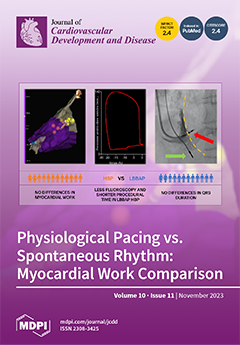Background: Sex-specific differences in heart disease outcomes are influenced by the levels of the steroid hormones, estrogen and testosterone. While the roles of estrogen receptors in cardiac disease are well-studied in animals and humans, respective research on androgen receptors (AR) is limited.
[...] Read more.
Background: Sex-specific differences in heart disease outcomes are influenced by the levels of the steroid hormones, estrogen and testosterone. While the roles of estrogen receptors in cardiac disease are well-studied in animals and humans, respective research on androgen receptors (AR) is limited. Here we investigate AR protein and mRNA expression in human myocardium of various cardiac diseases.
Methods: AR expression was analyzed by western blotting in myocardium from human non-failing hearts (NF, n = 6) and patients with aortic stenosis (AS, n = 6), hypertrophic cardiomyopathy (HCM, n = 7), dilated cardiomyopathy (DCM, n = 7), and ischemic cardiomyopathy (ICM, n = 7). Using an AR45-specific antibody, a subsequent western blot assessed samples from male and female patients with HCM (n = 10) and DCM (n = 10). The same sample set was probed for full-length
AR and
AR45 mRNA expression. Immunohistochemistry (IHC) localized AR in myocardium from HCM and AS hearts.
Results: Full-length AR was notably enriched in AS and HCM hearts compared to ICM, DCM, and NF. Similarly, AR45 was more abundant in HCM than in DCM. In contrast to the pattern observed for AR protein, full-length
AR mRNA levels were lower in HCM compared to DCM, with no discernible difference for the
AR45 isoform. Although gender differences in AR expression were not detected in western blots or qRT-PCR, IHC showed stronger nuclear AR signals in males than in females.
Conclusions: Our findings indicate disease-specific regulation of
AR mRNA and/or AR protein in cardiac hypertrophy, underscoring a potential role in this cardiac pathology.
Full article






